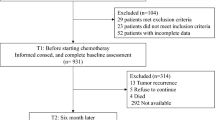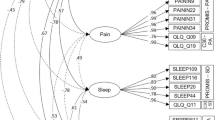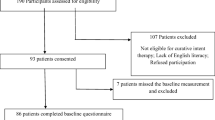Abstract
Two kinds of variables may be differentiated within instruments measuring health-related quality of life (HRQOL). Physical symptoms may be called causal variables because their occurrence can cause a change in HRQOL, but poor HRQOL need not necessarily imply that a patient suffers from these symptoms. Other items can be regarded as indicator variables. They reflect the level of HRQOL and a patient with a poor HRQOL is likely to have low scores on all indicator variables. The aim of this study was to test the relationship of the latent HRQOL construct to items and domains on the EORTC QLQ-C30. Confirmatory factor analysis was performed on EORTC QLQ-C30 data from 205 gastrointestinal cancer patients assessed one month after surgery. Functioning scales were established as variables indicating the level of HRQOL whereas all other subscales and items were established as variables causing a change in HRQOL. The model-data fit was satisfactory. Results support the hypothesis that two kinds of variables may be differentiated within HRQOL instruments. Further research should investigate whether both kinds of variables could be combined into a higher order, aggregate score for HRQOL.
Similar content being viewed by others
Abbreviations
- CFA:
-
Confirmatory factor analysis
- CFI:
-
Comparative Fit Index
- EORTC QLQ-C30:
-
European Organization for Research and Treatment of Cancer Quality of Life Questionnaire – Core
- HRQOL:
-
Health-related quality of life
- MIMIC:
-
Multiple indicator multiple cause
- RMSEA:
-
Root-mean-square error of approximation
- SMC:
-
Squared multiple correlation
- TLI:
-
Tucker Lewis Index
References
H McGee (2004) Quality of life A Kaptein J Weinman (Eds) Health Psychology The British Psychological Society and Blackwell Publishing Ltd Oxford 234–257
CA. McHorney (1999 ) ArticleTitleHealth status assessment methods for adults: past accomplishments and future challenges Annu Rev Public Health 20 309–335 Occurrence Handle10.1146/annurev.publhealth.20.1.309 Occurrence Handle1:STN:280:DyaK1M3otFWhtQ%3D%3D Occurrence Handle10352861
CC Gotay D Blaine SN Haynes J Holup IS Pagano (2002) ArticleTitleAssessment of quality of life in a multicultural cancer patient population Psychol Assess 14 439–448 Occurrence Handle12501569
BJ Zebrack MA Chesler (2001) ArticleTitleA psychometric analysis of the Quality of Life Cancer Survivors (QIO-CS) in survivors of childhood cancer Qual Life Res 10 319–329 Occurrence Handle10.1023/A:1012228823115 Occurrence Handle1:STN:280:DC%2BD38%2FjsVymtw%3D%3D Occurrence Handle11763245
PM Fayers DJ Hand (1997) ArticleTitleFactor analysis, causal indicators and quality of life Qual Life Res 6 139–150 Occurrence Handle1:STN:280:DyaK2szgsVyisg%3D%3D Occurrence Handle9161114
PM Fayers DJ Hand (2002) ArticleTitleCausal variables, indicator variables and measurement scales: an example from quality of life J R Statist Soc A 165 233–261 Occurrence Handle10.1111/1467-985X.02020
PM Fayers DJ Hand K Bjordal M Groenvold (1997) ArticleTitleCausal indicators in quality of life research Qual Life Res 6 393–406 Occurrence Handle1:STN:280:DyaK2svjsFKgsw%3D%3D Occurrence Handle9290306
D Borsboom GD Mellenberg J Heerden Particlevan (2003) ArticleTitleThe theoretical status of latent variables Psychol Rev 110 203–219 Occurrence Handle12747522
KA Bollen (1989) Structural Equations with Latent Variables Wiley & Sons New York
PM Fayers M Groenvold DJ Hand K Bjordal (1998) ArticleTitleClinical impact versus factor analysis for quality of life questionnaire construction J Clin Epidemiol 51 285–286 Occurrence Handle1:STN:280:DyaK1c7lsFSrsA%3D%3D Occurrence Handle9495694
NK Aaronson S Ahmedzai B Bergman et al. (1993) ArticleTitleThe European Organization for Research and Treatment of Cancer QLQ-C30: A quality-of-life instrument for use in international clinical trials in oncology J Natl Cancer Inst 85 365–376 Occurrence Handle1:STN:280:DyaK3s7msVarsQ%3D%3D Occurrence Handle8433390
PM Fayers NK Aaronson K Bjordal M Groenvold D Curran A Bottomley (2001) On behalf of the EORTC Quality of Life Group. The EORTC QLQ-C30 Scoring Manual (3rd Edition) European Organisation for Research and Treatment of Cancer Brussels
InstitutionalAuthorNameWHO (1948) World Health Organization Constitution WHO Geneva, Switzerland
JL Arbuckle W Wothke (1999) Amos 4.0 User Guide SmallWaters Chicago, IL
SY Lee WY Poon PM Bentler (1992) ArticleTitleStructural equation models with continuous and polytomous variables Psychometrika 57 89–105
SY Lee WY Poon PM Bentler (1990) ArticleTitleFull maximum likelihood analysis of structural equation models with polytomous variables Stat Probabil Lett 9 91–97
SY Lee JQ Shi (2001) ArticleTitleMaximum likelihood estimation of two-level latent variable models with mixed continuous and polytomous data Biometrics 57 787–794 Occurrence Handle1:STN:280:DC%2BD3MrgtFOhtw%3D%3D Occurrence Handle11550929
BO Muthen D Kaplan (1985) ArticleTitleA comparison of some methodologies for the factor analysis of non-normal likert variables Br J Math Stat Psychol 45 19–30
L Hu PM Bentler Y Kano (1988) ArticleTitleCan test statistics in covariance structure analysis be trusted? Psychol Bull 112 351–362
KG Joreskog D. Sorbom (1993) Lisrel8. Sturctural Equation Modeling with SIMPLIS Command Language Erlbaum Hillsdale, NJ
CP Chou P Bentler (1995) Estimates and tests in structural equation modeling R Hoyle (Eds) Structural Equation Modeling: Concepts, Issues, and Applications Sage Publications Thousand Oaks, CA 37–55
Tomarken AJ, Waller NG. Structural equation modeling: Strengths, limitations, and misconceptions. Annu Rev Clin Psychol November 11 2004; 1: 2.1–2.35; 10.1146/annurev.clinpsy.1.102803.144239
J Nevitt GR Hancock (2001) ArticleTitlePerformance of bootstrapping approaches to model test statistics and parameter standard error estimation in structural equation modeling Struct Equ Model 8 353–377 Occurrence Handle10.1207/S15328007SEM0803_2
GR Hancock J Nevitt (1999) ArticleTitleBootstrapping and the identification of exogenous latent variables within structural equation models Struct Equ Model 6 394–399
BG Tabachnick LS Fidell (2001) Using Multivariate Statistics Allyn & Bacon Needham Heights, MA 653–771
MW Browne R Cudeck (1993) Alternative ways of assessing model fit KA Bollen JS Long (Eds) Testing Structural Equation Models Sage Newbury Park, CA 136–162
KG Jöreskog D Sörbom (1996) LISREL 8 User’s Reference Guide Sci. Software Int. Chicago
LK Muthén BO Muthén (1998) Mplus User’s Guide Muthén & Muthén Los Angeles, CA
LK Muthén BO Muthén (2002) Mplus version 2.12: Addendum to the Mplus User’s Guide Muthén, Muthén Los Angeles, CA
DR Cox R Fitzpatrick AE Fletcher SM Gore DJ Spiegelhalter DR Jones (1992) ArticleTitleQuality-of-life assessment: can we keep it simple? J R Statist Soc A 155 353–393
L Prieto J Alonso MC Vildarich (1996) ArticleTitleScaling the Spanish version of the Nottingham Health Profile: Evidence of limited value of item weights J Clin Epidem Anto JM 49 31–38 Occurrence Handle1:STN:280:DyaK287ntlCrtQ%3D%3D
GW Torrance DH Feeny WJ Furlong RD Barr Y Zhang Q Wang (1996) ArticleTitleMultiattribute utility function for a comprehensive health status classification system: Health Utilities Index Mark 2 Med Care 34 702–722 Occurrence Handle10.1097/00005650-199607000-00004 Occurrence Handle1:STN:280:DyaK28zhsFCltg%3D%3D Occurrence Handle8676608
JP Browne CA O’Boyle H McGee NJ McDonald CRB Joyce (1997) ArticleTitleDevelopment of a direct weighting procedure for quality of life domains Qual Life Res 6 301–309 Occurrence Handle10.1023/A:1018423124390 Occurrence Handle1:STN:280:DyaK2szptFGhsg%3D%3D Occurrence Handle9248312
M Ryan S Farrar (2000) ArticleTitleUsing conjoint analysis to elicit preferences for health care Br Med J 320 1530–1533 Occurrence Handle1:STN:280:DC%2BD3c3psV2msA%3D%3D
Author information
Authors and Affiliations
Corresponding author
Rights and permissions
About this article
Cite this article
Boehmer, S., Luszczynska, A. Two Kinds of Items in Quality of Life Instruments: ‘Indicator and Causal Variables’ in the EORTC QLQ-C30. Qual Life Res 15, 131–141 (2006). https://doi.org/10.1007/s11136-005-8290-6
Accepted:
Issue Date:
DOI: https://doi.org/10.1007/s11136-005-8290-6




